

NY reg ITS architecture. ON regional ITS architecture. Service Package Diagram - ATIS1-Broadcast Traveller Information - Border Traveller Info Sys. ATIS01 - Broadcast Traveler Information. Description This service package collects traffic conditions, advisories, general public transportation, toll and parking information, incident information, roadway maintenance and construction information, air quality and weather information, and broadcasts the information to travelers using technologies such as FM subcarrier, satellite radio, cellular data broadcasts, and Internet web casts.
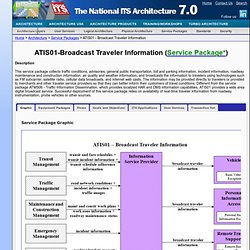
The information may be provided directly to travelers or provided to merchants and other traveler service providers so that they can better inform their customers of travel conditions. Different from the service package ATMS06 - Traffic Information Dissemination, which provides localized HAR and DMS information capabilities, ATIS01 provides a wide area digital broadcast service. Successful deployment of this service package relies on availability of real-time traveler information from roadway instrumentation, probe vehicles or other sources. Service Package Graphic Includes Architecture Flows: Information Service Provider Subsystem. The Information Service Provider Subsystem (ISPS) collects, processes, stores, and disseminates transportation information to system operators and the traveling public.

The subsystem can play several different roles in an integrated ITS. In one role, the ISP provides a data collection, fusing, and repackaging function, collecting information from transportation system operators and redistributing this information to other system operators in the region and other ISPs. In this information redistribution role, the ISP provides a bridge between the various transportation systems that produce the information and the other ISPs and their subscribers that use the information. The second role of an ISP is focused on delivery of traveler information to subscribers and the public at large.
Emissions Management Subsystem. This Emissions Management Subsystem (EMMS) operates at a fixed location and may co-reside with the Traffic Management Subsystem or may operate in its own distinct location depending on regional preferences and priorities.

This subsystem provides the capabilities for air quality managers to monitor and manage air quality. These capabilities include collecting emissions data from distributed emissions sensors within the roadway subsystem. These sensors monitor general air quality within each sector of the area and also monitor the emissions of individual vehicles on the roadway. The sector emissions measures are collected, processed, and used to identify sectors exceeding safe pollution levels. This information is provided to traffic management to implement strategies intended to reduce emissions in and around the problem areas. Parking Management Subsystem. The Parking Management Subsystem (PMS) provides electronic monitoring and management of parking facilities.

It supports a Field-Vehicle Communications link to the Vehicle Subsystem that allows electronic collection of parking fees and monitors and controls parking meters that support conventional parking fee collection. It also includes the instrumentation, signs, and other infrastructure that monitors parking lot usage and provides local information about parking availability and other general parking information. This portion of the subsystem functionality must be located in the parking facility where it can monitor, classify, and share information with customers and their vehicles. The subsystem also interfaces with the financial infrastructure and broadly disseminates parking information to other operational centers in the region.
Note that the latter functionality may be located in a back office, remote from the parking facility. Parking Management Subsystem. The Parking Management Subsystem (PMS) provides electronic monitoring and management of parking facilities.
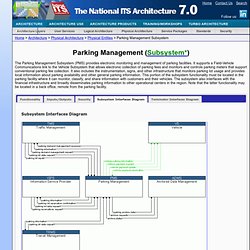
It supports a Field-Vehicle Communications link to the Vehicle Subsystem that allows electronic collection of parking fees and monitors and controls parking meters that support conventional parking fee collection. It also includes the instrumentation, signs, and other infrastructure that monitors parking lot usage and provides local information about parking availability and other general parking information. This portion of the subsystem functionality must be located in the parking facility where it can monitor, classify, and share information with customers and their vehicles. The subsystem also interfaces with the financial infrastructure and broadly disseminates parking information to other operational centers in the region.
Note that the latter functionality may be located in a back office, remote from the parking facility. Information Service Provider Subsystem. The Information Service Provider Subsystem (ISPS) collects, processes, stores, and disseminates transportation information to system operators and the traveling public.
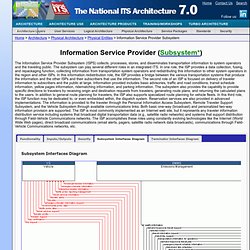
The subsystem can play several different roles in an integrated ITS. Personal Information Access Subsystem. The Personal Information Access Subsystem (PIAS) provides the capability for travelers to receive formatted traffic advisories from their homes, place of work, major trip generation sites, personal portable devices, over multiple types of electronic media.
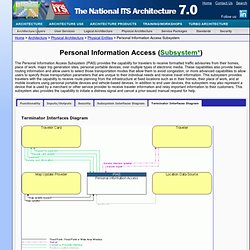
These capabilities also provide basic routing information and allow users to select those transportation modes that allow them to avoid congestion, or more advanced capabilities to allow users to specify those transportation parameters that are unique to their individual needs and receive travel information. This subsystem provides travelers with the capability to receive route planning from the infrastructure at fixed locations such as in their homes, their place of work, and at mobile locations using personal portable devices and vehicle-based devices. Subsystem Interfaces Diagram Get the Source Graphic, a Enhanced Windows Metafile (EMF), in ZIP format. Terminator Interfaces Diagram. Transit Management Subsystem. The Transit Management Subsystem (TRMS) manages transit vehicle fleets and coordinates with other modes and transportation services.

It provides operations, maintenance, customer information, planning and management functions for the transit property. It spans distinct central dispatch and garage management systems and supports the spectrum of fixed route, flexible route, paratransit services, transit rail, and bus rapid transit (BRT) service. The subsystem's interfaces allow for communication between transit departments and with other operating entities such as emergency response services and traffic management systems. This subsystem receives special event and real-time incident data from the traffic management subsystem. It provides current transit operations data to other center subsystems.
Subsystem Interfaces Diagram Get the Source Graphic, a Enhanced Windows Metafile (EMF), in ZIP format. Transit Management Subsystem. The Transit Management Subsystem (TRMS) manages transit vehicle fleets and coordinates with other modes and transportation services.
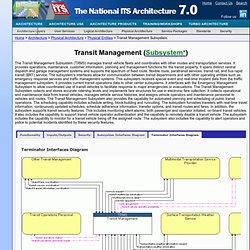
It provides operations, maintenance, customer information, planning and management functions for the transit property. It spans distinct central dispatch and garage management systems and supports the spectrum of fixed route, flexible route, paratransit services, transit rail, and bus rapid transit (BRT) service. The subsystem's interfaces allow for communication between transit departments and with other operating entities such as emergency response services and traffic management systems.
This subsystem receives special event and real-time incident data from the traffic management subsystem. It provides current transit operations data to other center subsystems. Subsystem Interfaces Diagram Get the Source Graphic, a Enhanced Windows Metafile (EMF), in ZIP format. Terminator Interfaces Diagram Get the Source Graphic, a Windows Metafile (WMF), in ZIP format. Transit Management Subsystem. The Transit Management Subsystem (TRMS) manages transit vehicle fleets and coordinates with other modes and transportation services.
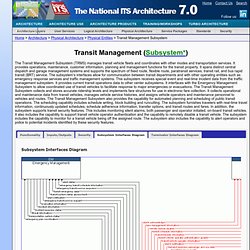
It provides operations, maintenance, customer information, planning and management functions for the transit property. It spans distinct central dispatch and garage management systems and supports the spectrum of fixed route, flexible route, paratransit services, transit rail, and bus rapid transit (BRT) service. The subsystem's interfaces allow for communication between transit departments and with other operating entities such as emergency response services and traffic management systems.
This subsystem receives special event and real-time incident data from the traffic management subsystem. It provides current transit operations data to other center subsystems. APTS03 - Demand Response Transit Operations. Description This service package performs automated dispatch and system monitoring for demand responsive transit services. This service performs scheduling activities as well as operator assignment.
In addition, this service package performs similar functions to support dynamic features of flexible-route transit services. This package monitors the current status of the transit fleet and supports allocation of these fleet resources to service incoming requests for transit service while also considering traffic conditions. APTS08 - Transit Traveler Information. Description This service package provides transit users at transit stops and on-board transit vehicles with ready access to transit information. The information services include transit stop annunciation, imminent arrival signs, and real-time transit schedule displays that are of general interest to transit users.
APTS11 - Multimodal Connection Protection. Description This service package supports the coordination of multimodal services to optimize the travel time of travelers as they move from mode to mode (or to different routes within a single mode). A near term function supported by this service package would be for a single transit agency to coordinate crossing routes so that passengers on one route would have the opportunity to transfer with minimum wait time to another route within the same transit system. The next level of complexity of this service package would be for this coordination to occur across transit agencies, or between transit agencies and other modes of transportation.
The most advanced functions of this service package would be to track the route of an individual traveler and ensure that connections are properly scheduled on an individual basis. This final capability represents a long-term functionality, which could be managed either through an Information Serviced Provider or through a Transit Management subsystem. APTS02 - Transit Fixed-Route Operations. Description This service package performs automated dispatch and system monitoring for fixed-route and flexible-route transit services.
This service performs scheduling activities including the creation of schedules, blocks and runs, as well as operator assignment. This service determines the transit vehicle trip performance against the schedule using AVL data and provides information displays at the Transit Management Subsystem. Static and real time transit data is exchanged with Information Service Providers where it is integrated with that from other transportation modes (e.g. rail, ferry, air) to provide the public with integrated and personalized dynamic schedules. Maintenance and Construction Management Subsystem. The Maintenance and Construction Management Subsystem (MCMS) monitors and manages roadway infrastructure construction and maintenance activities. Representing both public agencies and private contractors that provide these functions, this subsystem manages fleets of maintenance, construction, or special service vehicles (e.g., snow and ice control equipment).
The subsystem receives a wide range of status information from these vehicles and performs vehicle dispatch, routing, and resource management for the vehicle fleets and associated equipment. The subsystem participates in incident response by deploying maintenance and construction resources to an incident scene, in coordination with other center subsystems. Maintenance and Construction Management Subsystem. Emergency Management Subsystem. Emergency Management Subsystem. Archived Data Management Subsystem. The Archived Data Management Subsystem (ADMS) collects, archives, manages, and distributes data generated from ITS sources for use in transportation administration, policy evaluation, safety, planning, performance monitoring, program assessment, operations, and research applications.
Traffic Management Subsystem. The Traffic Management Subsystem (TMS) monitors and controls traffic and the road network. It represents centers that manage a broad range of transportation facilities including freeway systems, rural and suburban highway systems, and urban and suburban traffic control systems. MTQ Traffic Management Subsystem. MC03 - Road Weather Data Collection. Description This service package collects current road and weather conditions using data collected from environmental sensors deployed on and about the roadway (or guideway in the case of transit related rail systems).
In addition to fixed sensor stations at the roadside, sensing of the roadway environment can also occur from sensor systems located on Maintenance and Construction Vehicles. MC04 - Weather Information Processing and Distribution. Description. EM02 - Emergency Routing. Description. ATMS19 - Speed Warning and Enforcement. Description This service package monitors vehicle speeds and supports warning drivers when their speed is excessive. Also the service includes notifications to an enforcement agency to enforce the speed limit of the roadway. Speed monitoring can be made via spot speed or average speed measurements.
Roadside equipment can display the speed of passing vehicles and/or suggest a safe driving speed. Environmental conditions and vehicle characteristics may be monitored and factored into the safe speed advisories that are provided to the motorist. This service focuses on monitoring of vehicle speeds and enforcement of the speed limit while the variable speed limits service (covered in ATMS22-Variable Speed Limits service package) focuses on varying the posted speed limits to create more uniform speeds along a roadway, to promote safer driving during adverse conditions (such as fog) and/or to reduce air pollution. ATMS08 - Traffic Incident Management System. MC06 - Winter Maintenance.
Maine reg arch.